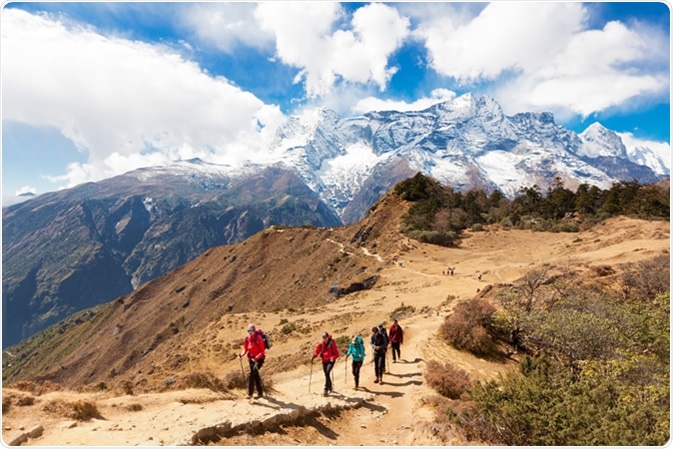
What Makes Different People More or Less Susceptible to Altitude Sickness?
Written by Lois Zoppi, BA, reviewed by Sophie Mullany, BSc
Millions of people every year travel to high altitude for a multitude of reasons including leisure, sports and long-term relocation, and the number of people travelling to high altitudes is only expected to increase with the growth of ecotourism and global adventure travel.
Altitude sickness is a range of pulmonary and cerebral conditions caused by hypoxia (oxygen deprivation) due to rapid ascent and poor pre-acclimatization to high altitudes. There are three types of altitude sickness, increasing in severity.

Image Credit: Oleandra / Shutterstock
Acute Mountain Sickness (AMS)
AMS is the most common form of altitude sickness. Symptoms of AMS are:
- Headache
- Nausea
- Vomiting
- Insomnia
- Fatigue
- Dizziness
- Loss of appetite
High-Altitude Cerebral Oedema (HACE)
In HACE, the brain ceases to function normally due to an accumulation of excess fluid.
High-Altitude Pulmonary Oedema (HAPE)
HAPE is related to HACE. Fluid enters the lungs due to leaks caused by excessive hypoxia.
Risk Factors
Altitude sickness affects 25 to 85 percent of people travelling to high altitude. The incidence rate of altitude sickness depends on various factors, including an individual’s age, gender, rate of ascent, home elevation, overall physical health, previous experience at altitude, and their individual susceptibility to altitude sickness.
Gender
The risk of developing altitude sickness between the genders is believed to be equal, but some observational studies have shown that women have a slightly higher risk than men.
Age
Similarly, there is little to suggest that incidence rates increase with age. One uncontrolled study suggested that younger people might be at higher risk, reporting that eighteen to nineteen-year olds had an incidence rate of 45%, meanwhile individuals between 60 and 87 years of age only reported a 16% incidence rate. It is thought that the results reflect the higher exercise intensity with younger people.
Exercise
At high altitude, an individual’s ability to exercise decreases. This is because the ventilatory response usually sufficient at sea-level to maintain good blood oxygen saturation is no longer possible due to the decreased oxygen levels at high altitude. Although those who are already in good physical health are better able to adapt to these changes during rapid ascent, data suggest that their risk of AMS is similar to individuals in poorer physical health.
Physical Health
Those with pre-existing diseases should show due caution when considering ascents to altitude. Those with heart failure are not advised to spend time in the hypoxic conditions of high altitudes. Although it is natural to believe that lung disease will rule out the possibility of high altitude travel, it is possible for individuals to travel to altitude following thorough evaluations and adequate prophylactic measures put in place before travel. This ensures the pre-existing condition is not worsened by the ascent and prevents altitude sickness.
Previous Experience at Altitude
It is more likely that individuals who have ascended to altitude without experiencing any symptoms of AMS will ascend to altitude again at later dates. Those who have had a recent exposure to altitude or exposure to extreme altitude are less likely to develop AMS.
Home Elevation
People travelling to high altitudes who usually live at sea-level are more susceptible to AMS than those who normally live at higher elevations.
Skiing resorts are commonly at an altitude of 3,000 meters, where the partial pressure of oxygen (PO2) is around 70% of the partial pressure at sea-level, and this partial pressure decreases even further at higher altitudes. Studies have shown that visitors to a Colorado ski resort who lived at sea-level reported a 27% risk of developing AMS to 8.4% of visitors who lived at about 1,000 meters.
Sleeping Altitude
The risk of developing AMS increases with sleeping altitude. Data suggest that mountaineers in the Swiss Alps saw a 9% prevalence of AMS at 2,850 meters and 53% at 4,559 meters. However, possibly due to prior experience at altitude, prevalence figures dropped above 5,000 meters, from 51% at 4,500 – 5,000 meters, to 34% above 5,000 meters.
Genetic Adaptations
Communities that have lived at altitude for thousands of years have developed particular genetic characteristics to cope with the conditions, such as higher haemoglobin concentration or higher ventilator responses. As no specific genetic factors contributing to AMS incidence have been concretely identified, this is an area of particular interest and is the subject of a lot of current research.
Summary
While the main cause of altitude sickness is poor pre-acclimatization and rapid ascent to high altitudes, there is little to suggest any particular demographic is significantly more susceptible than another. No significant differences between men and women or ages have currently been identified, and genetic reasons for suffering AMS are being actively investigated.
Sources
- http://erj.ersjournals.com/content/29/4/770.long
- http://err.ersjournals.com/content/26/143/160096#sec-15
- https://open.library.ubc.ca/media/download/pdf/52383/1.0343119/5
- https://www.aafp.org/afp/2010/1101/p1103.html
- https://www.ncbi.nlm.nih.gov/pmc/articles/PMC3617508/
- https://www.ncbi.nlm.nih.gov/pmc/articles/PMC3678789/#__sec11title
- www.physiology.org/.../jappl.2000.88.2.581
Further Reading
Last Updated: Aug 12, 2018






















.png)











No hay comentarios:
Publicar un comentario